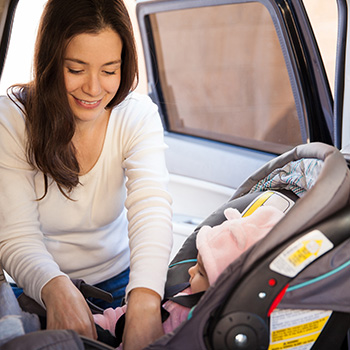Car Seat Safety Changes for 2014
 The NHTSA is changing their recommendations for the use of child car seats in 2014. The change takes into account the combined weight of the child and car seat while using the LATCH system, as opposed to going solely off the weight of the child.
The NHTSA is changing their recommendations for the use of child car seats in 2014. The change takes into account the combined weight of the child and car seat while using the LATCH system, as opposed to going solely off the weight of the child.
Most vehicles manufactured since September 1, 2002 are required to have the Lower Anchors and Tethers for Children, or LATCH, system for securing child safety seats. This system makes it easier to properly secure child seats in a way that will keep them safe during a crash. Even with this system, though, the NHTSA estimates that 3 out of 4 car seats are not used correctly!
Changes to LATCH Recommendations
The LATCH system was created to standardize car seat installation so that it would be the same on every car. Currently, the recommended weight limit for using the LATCH system is 40 lbs. Once the child is over 40 lbs, it was recommended that the seatbelt be used to secure the car seat instead of the LATCH system.
In February 2014, the recommendation is changing from 40lbs for the child to a 65 lb. weight limit for both child and car seat combined. Car seats can weigh anywhere from 15 to over 30 pounds, so it is no longer recommended to take only the weight of the child into account since this is not a standardized measurement.
With the new recommendation, parents only need to weigh the car seat with the child in it instead of weighing the car seat and child separately. Typically by the time the child is old enough to turn the car seat to front-facing, he will be nearing the LATCH weight limit anyway and you may as well use the seatbelt to secure the seat at this time.
Child Car Seat Guidelines
The guidelines for children and car seats are as follows:
Birth – 1 Year: Rear-Facing Car Seat
Infants should always be in a rear facing car seat. Some car seats are convertible and will transfer to a forward-facing car seat when the time comes. These usually have higher weight and height limits so you can keep the child facing backwards as long as possible, which is preferable.
1 – 3 Years: Forward-Facing Car Seat
Once your child has reached the height or weight limit of the rear facing car seat, it is time to transition to a forward facing car seat.
4 – 7 Years: Booster Seat
When your child exceeds the height or weight limit for a car seat, it is time to switch to a booster seat that is secured by the seat belt. This will allow for the seatbelt to properly secure the child. Booster seats, like car seats, should only be used in the back seat.
8 – 12 Years: Seat Belt in Back Seat
Once your child is big enough he can start using the seatbelt, but should remain in the back seat where it is safer until 12 years of age. To determine if your child is large enough for the seatbelt, the lap belt should lie across the lap, not the stomach, and the shoulder belt should lie across the chest and shoulder, not the face or neck.
Proper Car Seat Installation
One important aspect to note is that parents should not use both the LATCH and a seatbelt at the same time, because neither system was designed for this. Depending on the type of car and car seat you own, it may actually be easier to use the seat belt even when your child is an infant. Whatever works best for you to securely and properly install the car seat is what you should do. The LATCH system was not designed to be safer than the seatbelt, just easier to install correctly. If you’re not sure if your car seat is installed correctly, the NHTSA has car seat inspection stations located across the country where you can get your car seat checked and help installing it if needed.
Each state has their own laws regarding car seats and child passenger safety, so be sure you are up to date on the child safety laws in your state. If you follow these national recommendations, you should also be complying with any state law.
Categorized in: Driving, Laws, Safety Tips
